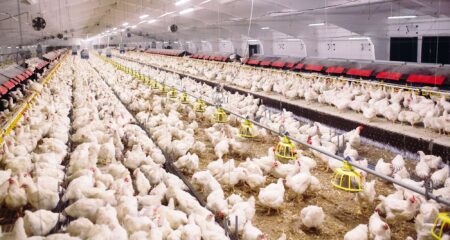By Joe Janzen, Scott Irwin, and Yu-Chi Wang
In the past five years, the renewable diesel boom has spurred new demand for soybean oil as a feedstock in production of biofuels. Soybean processors can respond to higher demand like this in multiple ways. Most obviously, they can crush more soybeans to produce more soybean oil. The downside to more crushing activity is more soybean meal, the other main product of the soybean crushing process. A lack of demand for this additional soybean meal may hurt soybean processing margins and keep soybean prices lower than they otherwise would be. Irwin and Good (2012, 2017) provided extensive analysis of the initial U.S. biodiesel boom that began in about 2008 with the implementation of the U.S. Renewable Fuels Standard. Figure 1 shows the approximate timing of this surge in U.S. biodiesel production and the more recent renewable diesel boom. Irwin (2017) found the initial biodiesel boom was accompanied by a concurrent increase in soybean meal demand, mitigating some of the potentially negative impacts of skewed soybean product demand on soybean prices.
farmdoc
In a recent article (Janzen and Wang, 2025), we showed crush composition changes are another important part of the soybean industry response to demand shifts. We identified two additional ways in which processors can respond to an increase in soybean oil demand: i) enhancing crush efficiency to get more oil and meal (and less waste) out of each bushel of soybeans and ii) changing the relative shares of oil and meal in the crush to get relatively more oil (and less meal and waste). While there are physical limits to such changes in crush composition, we found evidence for a long-run trend in annual data toward more soybean oil production driven by both crush efficiency and crush share mechanisms. Evidence of a push for more soybean oil production since the renewable diesel boom was limited by a small sample size. The renewable diesel boom is only about five years old, and it is difficult to draw conclusions from five data points.
To gain more insight on changes in the soybean crush, we analyze in this article monthly soybean crush data available since 2002. U.S. soybean oil production has increased steadily, particularly in the biofuels era beginning in about 2008. Soybean oil extraction rates have also grown over this period, but there was a persistent shift in soybean oil as a share of crush output beginning in the 2020/21 marketing year. Oil extraction rates have increased and now are routinely around 20% of output. Recall that the standard board crush margin calculation assumes 11 pounds of each 60-pound bushel of soybeans, or 18.3%, is oil.
This change in crush output comprises a significant share of growth in U.S. soybean oil production since 2020. We estimate roughly 40% of soybean oil output increases (relative to pre-2020 trends) in the last five years are the result of changes in the composition of the crush. Gains in crush efficiency, rather than changes in oil-relative-to-meal shares, account for most of the increase. Future articles in this series will consider how the renewable diesel boom has already affected markets and margins in soybean processing, plus the long-run ramifications for soybean prices of changing demand for soybean products.
Recent Growth in U.S. Soybean Oil Production
U.S. soybean oil production has increased substantially over time. Figure 2 shows monthly oil production data from the National Oilseed Processors Association (NOPA) since October 2002, the start of the 2002/03 October-to-September marketing year for soybean oil. (NOPA data cover roughly 95% of U.S. output. Unlike USDA National Agricultural Statistics Service data on soybean crushing, historical data are continuously available for a longer period.) Beginning around the 2008/09 marketing year, soybean oil production saw roughly straight-line growth of 3.3 million pounds per month or 40 million pounds per year. An increase of 40 million pounds is small relative to the approximately 27 billion pounds the U.S. will produce this marketing year. However, the accumulation of these year-over-year changes mean that soybean oil production is 47% greater today than it was in 2008.
farmdoc
We use the linear trend in soybean oil production growth as a baseline against which to compare observed production during the renewable diesel boom period that began in 2020. Comparing observed production to this baseline (given by the dashed line in Figure 2) suggests that soybean oil production growth may have increased since 2020, but only slightly. On average, monthly production was about 82 million pounds above trend since October 2020 and there have been many months in the post-2020 period where soybean oil production was below the pre-2020 trend. That the soybean industry has not rapidly increased production makes sense given a lack of idle crush capacity before 2020 and the significant investment costs and time lag associated with building new crush plants. Soybean processors have moved to increase crushing capacity, but new and expanded crush plants did not come online until relatively recently (Gerlt, 2025).
Soybean Oil Extraction Rates Have Jumped
Changing the composition of the soybean crush is the other way to find the soybean oil necessary to meet demand generated by the renewable diesel boom. Figure 3 shows monthly soybean oil extraction rates since October 2002. There is considerable month-to-month variation in extraction rates which to some extent reflect regional and inter-year differences in the physical properties of the soybeans processed at given points in time. Figure 3 also plots the linear trend in extraction rates for the period prior to the 2020/21 marketing year. Like the long-run trend found in annual data (see Janzen and Wang, 2025), the trend in monthly soybean oil extraction rates is positive. It shows an average annual increase of 0.03 percentage points per year, similar in magnitude to the 1964/65 to 2024/25 trend estimated in that earlier article.
farmdoc
There is a notable difference in Figure 3 between the post-2020 values and the pre-2020 trend. Since the start of the 2020/21 marketing year, soybean oil extraction rates have consistently been above trend. Maintaining the pre-2020 trend between 2020 and 2025 would imply an extraction rate of approximately 19.5%. Instead, the realized U.S. soybean oil extraction rate jumped to 19.7% in late 2020 and then continued to increase to around 20.0% for much of 2025. (November and December in both 2022 and 2023 were short-lived exceptions to this otherwise persistent shift.) These data clearly indicate a change in the composition of U.S. soybean oil output that cannot be explained by long-run gains in processing efficiency or similarly slow-moving forces like the development of higher oil content soybean varieties.
The post-2020 jump in soybean oil extraction rates indicates that soybean processors have been able to squeeze more oil from the soybean crush process. While the specific process behind this jump is not revealed in the available data, it is reasonable to think given its timing that this is a response to increased soybean oil demand.
Higher Oil Extraction Rates Are a Significant Contributor to Oil Production Growth
To quantify how much additional soybean oil was generated by changes in the composition of the crush shown in Figure 3, we convert the deviations from trend in the soybean oil share of the crush into pounds of soybean oil. Multiplying the above-trend oil share by the number of pounds of soybeans crushed gives the ‘extra’ production generated by changes in crush composition. For example, the soybean oil extraction rate was 20.0% in July 2025 and the trendline rate was 19.6%. We assume the 0.4 percentage point difference is the crush composition effect of increased soybean oil demand. Multiplying by the 11.7 billion pounds of soybeans crushed in July 2025 suggests crush composition changes generated an additional 43.9 million pounds of soybean oil.
farmdoc
To place this additional soybean oil production in context, we break down observed soybean oil production for the marketing years since 2020/21 into three components: a baseline value given by the pre-2020 trend plotted in figure 2, the crush composition effect described above based on increased soybean oil share in the crush, and a residual that must be the result of additional bushels of soybeans crushed.
We find a significant share of above-trend soybean oil production since 2020/21 is due to ‘more oil’, the crush composition effect we described above. In aggregate, approximately 30% of above-trend soybean oil production since 2020/21 was due to the jump in soybean oil extraction rates. Figure 4 plots this decomposition by marketing year. The crush composition effect is proportionally greater in earlier years where crush capacity, and thus the ability to simply process more soybeans, was limited. However even in the last two marketing years, the crush composition effect was about 20% of observed soybean oil production growth.
Conclusion
The renewable diesel boom has coincided with significant shifts in the quantity and composition of soybean crush output. Even though we typical assume soybeans have fixed proportions of oil and meal, soybean processors have managed to squeeze more oil out of U.S. soybeans since 2020. While the extra oil quantity is small in the context of the roughly 27 billion pounds of oil produced in the U.S. this year, it makes up a significant share of soybean oil production growth in the past five years.
Recent EPA rulemakings may spur another phase of the renewable diesel boom. The possibility of further growth in biomass-based diesel production raises a number of questions. What scope does the soybean industry have to further alter the composition of the crush, and if so, over what time frame can such changes occur? How will soybean and soybean product markets mediate this shift? How will the addition of new and expanded soybean crush capacity interact with changes in crush composition?
Future articles will describe the economics of past quantity changes to inform expectations about the future of soybean production and processing. For example, we will explain how markets and margins in soybean processing adjusted in the past five years and examine the long-run ramifications for soybean prices of changing demand for soybean products.
The Soybean Industry Response to the Renewable Diesel Boom, Part 2: Squeezing More Oil From the Soybean Crush was originally published by Farmdoc.


:max_bytes(150000):strip_icc()/IMG_1591-2048x1365-362687ca596f4814967abffff2b4be2c.jpg)
:max_bytes(150000):strip_icc()/SuccessfulFarmingShareImage-8fed6410b43147a19ed5ea1e3243227f.png)



:max_bytes(150000):strip_icc()/28533ripesoybeans_soybeans-01d6026d90324818a2c9daf57e26b0cd.jpg)

:max_bytes(150000):strip_icc()/IMG_7575-ac6db3006a2145109bcc2df421c7a962.jpeg)

:max_bytes(150000):strip_icc()/Markets-3-Corn-up-3-19bdbeee0041452db8bce0a0f1c8b883.jpeg)